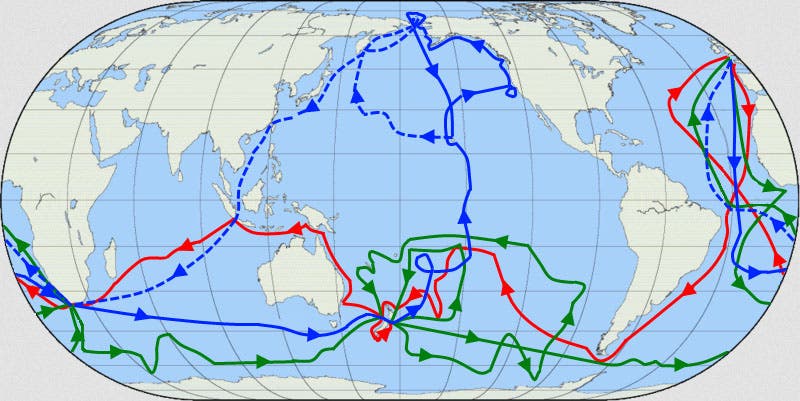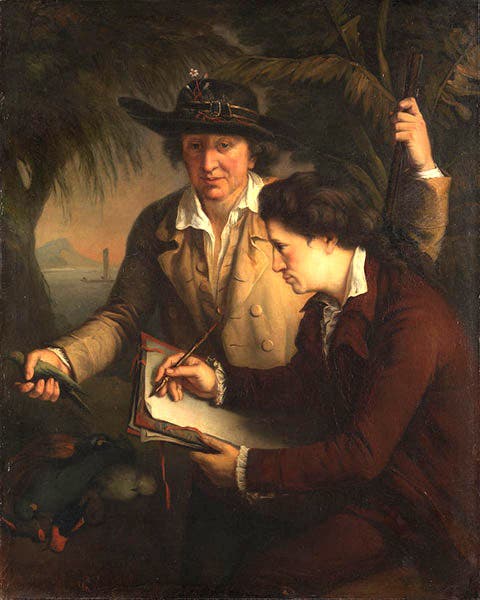Scientist of the Day - James Cook
On July 11, 1772, Captain James Cook sailed from Plymouth on his second voyage around the world. He had been back in England only 14 months since returning from the initial voyage of 1768-71, which was successful beyond anyone's expectations, in discovering new lands and peoples, observing the transit of Venus of 1769 in Tahiti, and collecting specimens, descriptions, and illustrations of thousands of new plants and animals. Cook was aided in this last enterprise by a team headed up by the naturalist Joseph Banks. We told the story of the first voyage in our first post on Cook and in posts on Banks; Sydney Parkinson, an artist who died on the voyage; and Daniel Solander, a Swedish naturalist employed by Banks.
The single ship of the first voyage, HMS Endeavor, had been built in the shipyards of Whitby in north Yorkshire, and it had done its job well, but it had lived a full life in those 3 years, and for his second voyage, Cook was provided with two more Whitby-built vessels, the Resolution, which he commanded, and the Adventure, commanded by Thomas Furneaux. Cook's primary mission, as detailed by the Admiralty (with further guidelines provided by the Royal Society of London) was to search for a southern continent, and to explore New Zealand and other island groups of the vast Pacific Ocean.
The ships were stocked with all sorts of anti-scorbutics (foods to ward off scurvy), including sauerkraut, malt, carrot jam, and beer concentrate – some were known anti-scorbutics, some were to be tested out. Cook's first voyage had been relatively scurvy-free, and he wanted to keep it that way on the second trip. The Resolution also carried one of the new chronometers of John Harrison, which allowed navigators to determine longitude, even in the middle of the Pacific. It worked as advertised, and K1 survives today in the National Maritime Museum in Greenwich (fourth image). In addition, Cook had an able artist, William Hodges, and two naturalists, Johann Reinhold Forster and his son Johann Georg. It had been intended that Banks would be the naturalist for the second voyage, but he resigned in a huff when his on-deck space had to be cut down in size. The Forsters performed well in his stead (fifth image).
The ships stopped first in Cape Town to replenish with fresh food and water, and then sailed directly south to tackle their primary mission – search for and hopefully discover a southern continent. They failed to sight Antarctica, but they did cross the Antarctic Circle on Jan 17, 1773, the first ship to do so, and saw lots of penguins and ice floes, but no land (see map, third image). The icy fog grew so thick that the two ships lost touch with each other and would not be reunited until they met again in New Zealand, which the Resolution reached in March. The Adventure was waiting for them in Queen Charlotte's Bay up north, but Cook took his time exploring the southern island and didn't reunite with Furneaux's ship until late May.
The ships then left to explore the Pacific, re-visiting Tahiti, and encountering, for the first time, the Society Islands and the Friendly Islands, collecting specimens all the way (including taking on board a native from Huahine named Omai, who would make it back to England and become quite an ambassador for Pacific Islanders). By October of 1773, they made it back to New Zealand's North Island. The two ships were again separated during a storm, and a landing party from the Adventure was attacked and slaughtered by natives – ten men were butchered – which so unnerved Furneaux that he immediately headed back to Cape Town and then home, a year ahead of Cook. Cook was unaware of this, and in the Antarctic summer of January 1774, he made one more attempt at discovering Antarctica, this time making it to 71° 11' south, a record for “furthest south” that would stand until the 1840s (see map, third image). But the ice floes were too thick to go further, and he returned to warmer climes, discovering, among other things, Easter Island, which had not been visited by Englishmen. Nearly every picturesque place they visited was painted by Hodges, and you can see his painting of Easter Island as the initial image in our post on Hodges.
HMS Resolution returned to Spithead in England on July 20, 1775, after a circum-navigating voyage of just over 3 years. Even though Cook did not discover Antarctica, the voyage was an unqualified success, and with the specimens collected by the Forsters, and their drawings, it was a scientific success as well. Cook’s first voyage had been written up by John Hawkesworth, but that publication was a disaster, so Cook was in charge of the narrative for the second voyage, published in 1777, with engravings after the drawings and paintings of Hodges and the two Forsters. We have only the fourth edition in our library, but the engravings are the same ones as in the first edition. You can see two of the engravings here, and four more, including Hodges’ portrait of Cook, in our post on Hodges.
Cook would set out on his third voyage, another circumnavigation, just a year later, in July of 1776, a voyage from which he would not return. We will tell that story in one last post on James Cook, at some future date.
William B. Ashworth, Jr., Consultant for the History of Science, Linda Hall Library and Associate Professor emeritus, Department of History, University of Missouri-Kansas City. Comments or corrections are welcome; please direct to ashworthw@umkc.edu.












